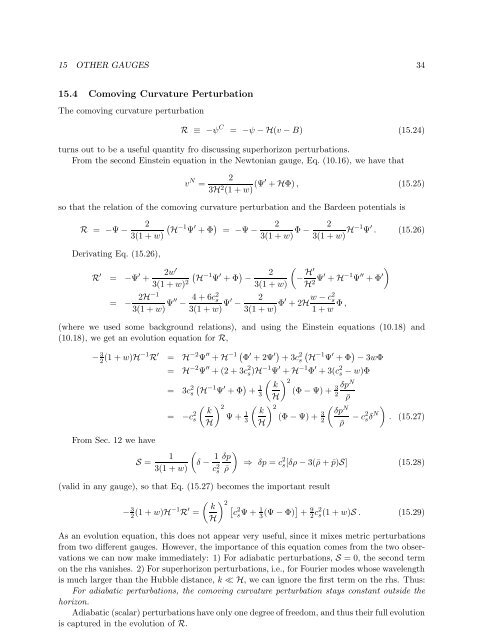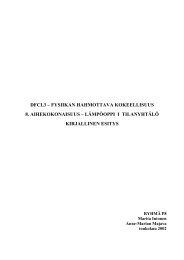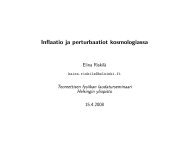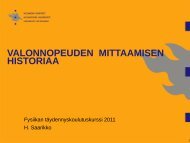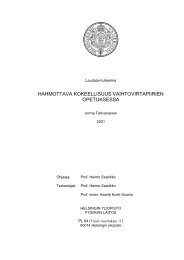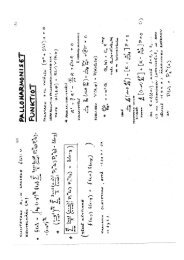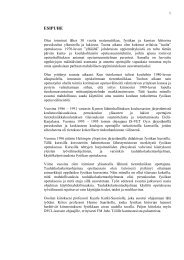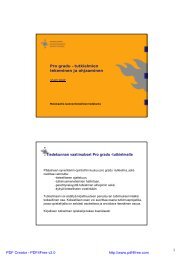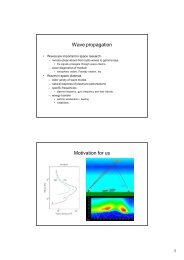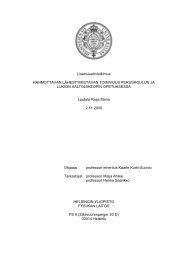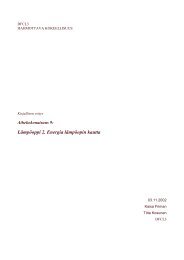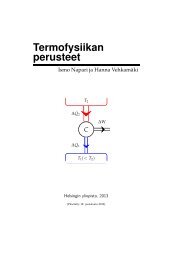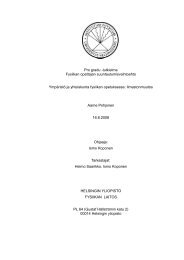Cosmological Perturbation Theory, 26.4.2011 version
Cosmological Perturbation Theory, 26.4.2011 version
Cosmological Perturbation Theory, 26.4.2011 version
Create successful ePaper yourself
Turn your PDF publications into a flip-book with our unique Google optimized e-Paper software.
15 OTHER GAUGES 3415.4 Comoving Curvature <strong>Perturbation</strong>The comoving curvature perturbationR ≡ −ψ C = −ψ − H(v − B) (15.24)turns out to be a useful quantity fro discussing superhorizon perturbations.From the second Einstein equation in the Newtonian gauge, Eq. (10.16), we have thatv N =23H 2 (1 + w) (Ψ′ + HΦ), (15.25)so that the relation of the comoving curvature perturbation and the Bardeen potentials isR = −Ψ −2 (H −1 Ψ ′ + Φ ) 2= −Ψ −3(1 + w)3(1 + w) Φ − 23(1 + w) H−1 Ψ ′ . (15.26)Derivating Eq. (15.26),R ′ = −Ψ ′ 2w ′ (+H −13(1 + w) 2 Ψ ′ + Φ ) )2−(− H′3(1 + w) H 2Ψ′ + H −1 Ψ ′′ + Φ ′= − 2H−13(1 + w) Ψ′′ − 4 + 6c2 s 23(1 + w) Ψ′ −3(1 + w) Φ′ + 2H w − c2 s1 + w Φ ,(where we used some background relations), and using the Einstein equations (10.18) and(10.18), we get an evolution equation for R,− 3 2 (1 + w)H−1 R ′= H −2 Ψ ′′ + H −1 ( Φ ′ + 2Ψ ′) + 3c 2 (s H −1 Ψ ′ + Φ ) − 3wΦ= H −2 Ψ ′′ + (2 + 3c 2 s)H −1 Ψ ′ + H −1 Φ ′ + 3(c 2 s − w)Φ) 2(Φ − Ψ) + 3 δp N2= 3c 2 (s H −1 Ψ ′ + Φ ) ( k+ 1 3H( ) k 2 ( k= −c 2 s Ψ + 1H3H¯ρ) 2 ( δp(Φ − Ψ) + 3 N)2¯ρ − c2 sδ N . (15.27)From Sec. 12 we haveS =13(1 + w)(δ − 1 c 2 s)δp¯ρ⇒ δp = c 2 s[δρ − 3(¯ρ + ¯p)S] (15.28)(valid in any gauge), so that Eq. (15.27) becomes the important result( ) k 2− 3 2 (1 + w)H−1 R ′ [= c2H s Ψ + 1 3 (Ψ − Φ)] + 9 2 c2 s (1 + w)S . (15.29)As an evolution equation, this does not appear very useful, since it mixes metric perturbationsfrom two different gauges. However, the importance of this equation comes from the two observationswe can now make immediately: 1) For adiabatic perturbations, S = 0, the second termon the rhs vanishes. 2) For superhorizon perturbations, i.e., for Fourier modes whose wavelengthis much larger than the Hubble distance, k ≪ H, we can ignore the first term on the rhs. Thus:For adiabatic perturbations, the comoving curvature perturbation stays constant outside thehorizon.Adiabatic (scalar) perturbations have only one degree of freedom, and thus their full evolutionis captured in the evolution of R.


